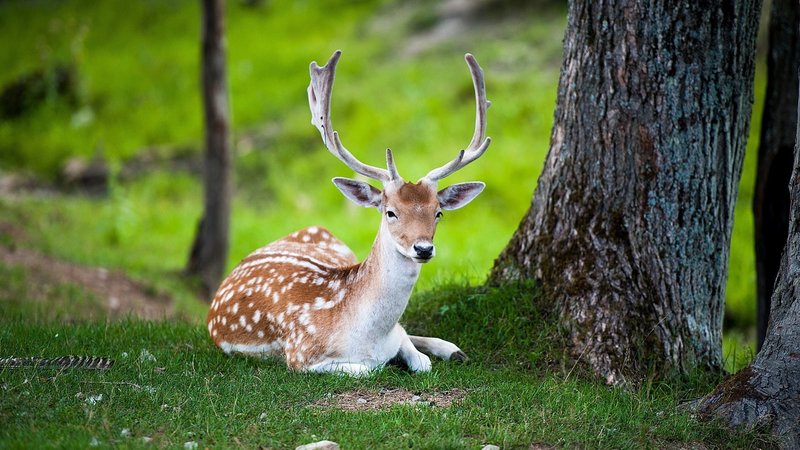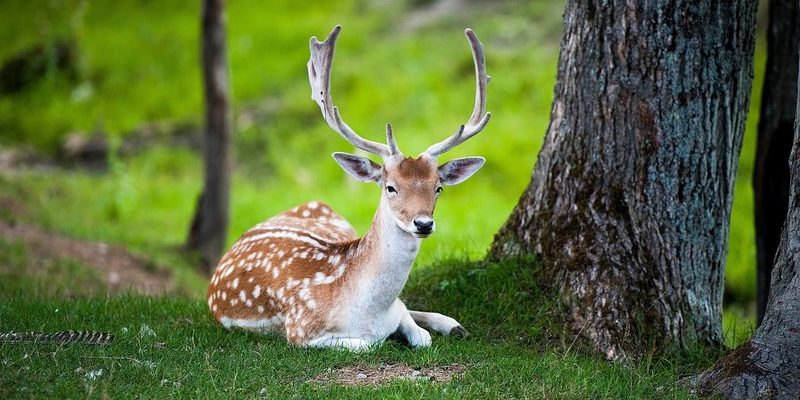
When you think of the woods, what comes to mind? The rustling of leaves, a burst of movement, and suddenly there it is—a deer, leaping gracefully through the underbrush. Deer are one of the most captivating animals to encounter in the wild. They embody both elegance and strength, making them a favorite among nature lovers and wildlife photographers alike. But there’s so much more to deer than their stunning appearance.
Deer belong to the family Cervidae and are found across the globe, from the snowy forests of Canada to the sunlit savannas of Africa. Their adaptability allows them to thrive in varied habitats. You’ll find them living in forests, grasslands, and even suburban areas where nature meets civilization. This article will take you on a journey through the world of deer, exploring their characteristics, behaviors, and what makes them truly unique.
What are Deer?
Deer are herbivorous mammals known for their antlers, which are primarily found on males. While there are many species of deer, they share common characteristics, including a slender body, long legs, and a specialized digestive system that allows them to efficiently process fibrous plant materials. They play a crucial role in their ecosystems, contributing to plant growth and serving as prey for larger predators.
There are several species of deer globally, with some of the most recognizable being the white-tailed deer, mule deer, and the majestic elk. Each species has adapted to its environment in interesting ways. For instance, the white-tailed deer is known for its distinctive tail, which it raises to signal danger to others in the herd. This communication is vital in helping them avoid predators.
Physical Characteristics of Deer
Deer vary significantly in size, color, and weight, depending on the species. Most have a sleek, elegant build that allows for quick movement through their habitats. For instance, the average adult white-tailed deer stands about 3 feet tall at the shoulder and weighs between 100 to 300 pounds. Their coats are typically brown or reddish-brown, which helps them blend into their surroundings.
Antlers are perhaps the most distinguishing feature of male deer. These bony structures are unique because they are shed and regrown annually, usually starting to grow in the spring and falling off in the winter. Antlers serve multiple purposes, including attracting mates and establishing dominance among other males. The process of antler growth involves a rich supply of blood vessels and nutrients, making it a fascinating aspect of their biology.
| Species | Size | Weight | Habitat | Diet |
| White-tailed Deer | 3 – 3.5 ft | 100 – 300 lbs | Forests, fields | Herbivore |
| Mule Deer | 3 – 3.5 ft | 150 – 250 lbs | Western US | Herbivore |
| Elk | 4 – 5 ft | 600 – 800 lbs | Forests, mountains | Herbivore |
Habitat and Distribution of Deer
You might be surprised to learn just how widely deer are distributed. They thrive in various climates, from the icy tundra of Alaska to the warm, humid southeastern United States. Deer adapt their behaviors and diets based on the available resources in their habitat. For example, in denser forests, they may rely more on leaves, while in open fields, they might graze on grasses.
Communication is key for deer. When they sense danger, they rely on their acute sense of hearing and smell to detect threats. This ability to communicate with one another, combined with their agility, helps them evade predators. Additionally, deer are known to migrate depending on the season, searching for food and more favorable conditions. This seasonal movement is not just instinct—it’s critical for their survival.
Behavior and Social Structure
Deer are social animals that often live in groups known as herds. The social structure usually comprises females and their offspring, while males may either remain solitary or form small bachelor groups. Female deer, or does, are more likely to stay close-knit with their young, providing protection and teaching them essential survival skills.
You might be wondering how deer interact within these groups. They communicate through a mix of body language, vocalizations, and even scents. For instance, during mating season, males will engage in behaviors such as sparring with their antlers to establish dominance. This competition not only determines breeding rights but also influences the overall hierarchy within the herd.
Diet and Feeding Habits
Deer are primarily herbivores, with their diet consisting of a variety of plants, including leaves, twigs, fruits, and flowers. They have a unique digestive system that allows them to process tough plant materials efficiently. This helps them survive in environments where food may be scarce. Deer are known to be selective feeders, meaning they often choose the most nutritious plants available.
Interestingly, deer have a four-chambered stomach, which aids in breaking down their food. They’ll often chew their food, swallow it, and then regurgitate it as a cud to chew again. This process not only maximizes nutrient absorption but also allows them to thrive in diverse habitats where food sources vary.
Reproduction and Life Cycle
Reproduction in deer typically involves a mating season during the fall, known as the rut. During this time, males become more aggressive and start to display their antlers to attract females. After successful mating, the gestation period for most deer species lasts about six to seven months.
Once the fawns are born, they are hidden in tall grass or thick cover to protect them from predators. Mothers are very attentive, nursing their fawns and keeping them safe from harm. Fawns are usually weaned by the time they’re around two to three months old and will stay with their mothers for about a year before venturing out on their own.
Common Predators of Deer
While deer are adept at evading many predators, they are still susceptible to attacks from larger carnivores. Common predators include wolves, coyotes, and mountain lions. These predators rely on their stealth and hunting skills to catch deer, especially during the fawning season when young deer are more vulnerable.
Interestingly, humans also pose significant threats to deer populations through habitat destruction, poaching, and vehicle collisions. It’s crucial to balance wildlife conservation efforts with human development to ensure these magnificent creatures continue to thrive for future generations.
Conservation Efforts and Challenges
With their delicate balance in ecosystems, deer conservation is vital. Many organizations work tirelessly to educate the public on the importance of sustainable practices and habitat protection. Maintaining a healthy deer population benefits not only the species itself but the numerous other organisms depending on them.
Challenges persist, however, as overpopulation can lead to increased vehicle accidents and agricultural damage. States and regions often implement regulations, such as hunting quotas and wildlife corridors, to manage deer populations and minimize negative impacts on human activities. Community involvement in conservation practices is also essential for fostering a deeper understanding of wildlife stewardship.
Frequently Asked Questions
What do deer eat?
Deer are primarily herbivores and enjoy a varied diet of leaves, twigs, fruits, and grasses. Depending on the season and availability, they might eat acorns, berries, and even cultivated crops in agricultural areas. Their selective feeding behavior helps them thrive in diverse habitats, allowing them to choose the most nutritious options available.
Where do deer live?
Deer are incredibly adaptable and can be found in a wide range of environments, from dense forests and grasslands to suburban areas. Their habitat choices vary by species, with some preferring mountain regions while others thrive in valleys or wetlands. Wherever they are, they play essential roles in their ecosystems.
How fast can deer run?
Deer are built for speed and can reach impressive speeds of up to 30 miles per hour. This agility is key for evading predators in the wild. They also have a unique ability to leap over obstacles, helping them navigate through dense forests and rough terrains.
Do all deer have antlers?
Not all deer have antlers. Typically, only male deer grow antlers, which they shed and regrow annually. Some species exhibit variations in antler size and shape. Female deer, however, do not develop antlers but play significant roles in their social structures and nurturing of fawns.
What are the main threats to deer populations?
Deer populations face various threats, including habitat loss due to urban development, poaching, and vehicle collisions. Natural predators also impact their numbers, but human activities pose significant challenges to their survival. Conservation efforts aim to mitigate these threats and protect deer habitats.
How long do deer live?
The lifespan of deer varies by species and environmental conditions. In the wild, deer typically live around 6 to 14 years, while those in protected areas may live longer due to fewer threats. Factors such as food availability and predation significantly influence their longevity.
Can deer swim?
Yes, deer are excellent swimmers! They can swim across rivers and lakes with ease, using their long legs to paddle through the water. This ability often comes in handy when they need to escape predators or navigate through their habitats.
Are deer dangerous to humans?
Generally, deer are not dangerous to humans and will usually flee if approached. However, during mating season or if they feel threatened, they may become aggressive. Vehicle collisions are a more significant concern, as deer can unexpectedly dart onto roads, leading to accidents.
How do deer communicate?
Deer communicate using various vocalizations, body language, and scent marking. They might grunt or snort to signal alarm, while females and fawns will communicate through soft bleats. Additionally, they leave scent markings to establish territory and signal reproductive readiness.
What do deer symbolize in various cultures?
Deer have rich symbolic meanings in many cultures, often representing grace, gentleness, and alertness. In some traditions, they are seen as messengers between humans and the spirit world. Their gentle nature and ability to thrive in the wild make them beloved figures in mythology and folklore.
What are the differences between male and female deer?
The most noticeable differences between male and female deer are antlers and size. Males, or bucks, grow antlers, which they shed annually, while females, or does, do not. Generally, males are larger than females, especially in species like elk. Their social roles and behaviors also vary, particularly during mating season when competition among males intensifies.

